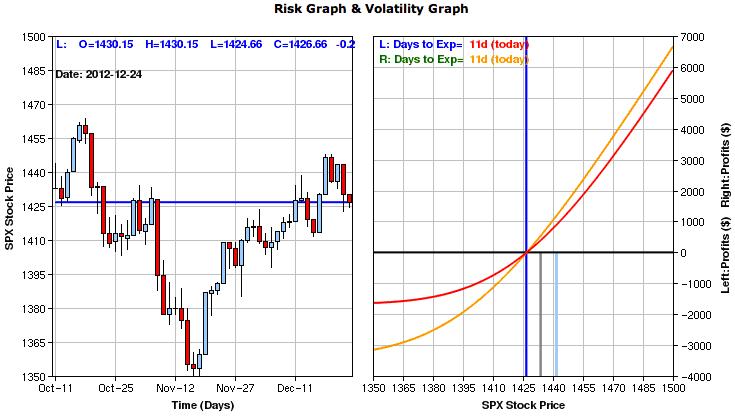 Explore Your Options
Explore Your OptionsQ&A
 Explore Your Options
Explore Your OptionsGot a question about options? Tom Gentile is the chief options strategist at Optionetics (www.optionetics.com), an education and publishing firm dedicated to teaching investors how to minimize their risk while maximizing profits using options. To submit a question, post it on the Stocks & Commodities website Message-Boards. Answers will be posted there, and selected questions will appear in future issues of S&C.
’TIS THE SEASON...TO BUY OPTIONS
With December now upon us, what’s a trader to do? As everyone starts planning their holiday parties, their vacations, and of course, their gift-buying, the market, too, is in planning mode. There are gifts from Father Wall Street for those who bear (no pun intended) to look for them. They come in the form of seasonality. Let’s take a look at a well-known seasonal pattern with an approach that’s an alternative to sticking your neck out with stocks or futures.
SANTA CLAUS RALLY
The Santa Claus rally was first observed by my friends at the Stock Trader’s Almanac. Yale Hirsch and his son Jeff came across the so-called seasonal week back in the 1970s. Jeff, who has taught at several of our seminars in the past, says the rally consists of the last five trading days of the year plus the first two following New Year’s Day. Don’t confuse this with the “January effect” — that’s a different seasonal pattern.
Jeff says that his father went back as far as 1950 with this Christmastime pattern and found that the S&P 500 averaged around 1.5% during that week. Not huge gains, but gains none the less. He goes on to tell me that this is mainly due to lower volume, general lack of news, and the pros buying into the end of the year.
Let’s change this around a bit to look at options as an alternative way to invest in this seasonal pattern. To do so, we’ll look at last year’s Santa Claus rally and what alternatives there were to buying stocks, exchange traded funds (ETFs), or futures during that short time frame.
If you were to buy the SPX at the open of December 24, 2012 and get in at the closing price of 1426.66 and then sell the position on the close of January 3, 2013 at 1459.37, you would have a profit of 32.71, or a 2.2% gain. But what would happen if you were to trade options during this time frame? I analyzed two different positions using the January options on the following short-term trading strategies:
The chart on the left in Figure 1 is the price action of the SPX. The chart on the right represents the risk graph of both positions overlaid on each other. The line to the right in red is the 1425 call, while the line in orange is the 1400 call. Note the 1425 call has less risk, but moves up slower as the position gains value to expiration.

FIGURE 1: RISK AND VOLATILITY GRAPH. The 1425 call has less risk but moves up slower as the position gains value to expiration.
Fast forward to January 4, 2013: You already know — thanks to the benefit of hindsight — that this strategy worked rather well for the SPX itself, but how well did it work for these short-term options?
Based on the closing price of SPX at 1459.37, both positions ended up profitable. But which one was the better choice? That could be up for debate, depending on the trader. The ATM call option had the higher return on investment at 93.4% versus 69.5% for the ITM call option. However, in a dollar-for-dollar contest, the ITM option returned $2,350 profit, while the ATM option returned $1,565.
Clearly (or not), there is no right answer here. My opinion will continue to stay the same, however, which is: The shorter-term options that I purchase, the deeper ITM I go, because with expiration just a few days away, time decay can happen rather fast. By the way, for those of you pinching pennies during the holiday season, if this seems like too much money for your account size, consider trading an ETF such as the SPY, which mimics the S&P 500, but at one tenth the cost and risk. The options are similar in cost and risk as well.
Merry Christmas to calls, and to calls I don’t write...